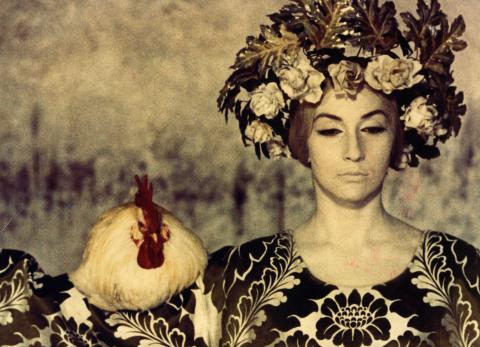THE COLOR OF POMEGRANATES: Soviet Surrealism

This essay on The Color of Pomegranates (Sayat Nova, 1969) was written by James Steffen, Ph.D., the Film and Media Studies Librarian at Emory University and author of The Cinema of Sergei Parajanov (University of Wisconsin Press, 2013). Steffen will introduce a screening of the film at 7 p.m. on Friday, November 13 in 4070 Vilas Hall. The screening will be followed by a talk about the film and its restoration.
The 2014 restoration is by Cineteca di Bologna/L’Immagine Ritrovata and The Film Foundation’s World Cinema Project, in association with the National Cinema Centre of Armenia and Gosfilmofond of Russia. Restoration funding provided by the Material World Charitable Foundation and The Film Foundation.
By James Steffen
Martin Scorsese, a longtime admirer of Parajanov’s work and the driving force behind this restoration, wrote in the Il Cinema Ritrovato festival catalog: “Watching Sergei Parajanov’s The Color of Pomegranates, or Sayat Nova, is like opening a door and walking into another dimension, where time has stopped and beauty has been unleashed. On a very basic level, it’s a biography of the Armenian poet Sayat-Nova, but before all else it’s a cinematic experience, and you come away remembering images, repeated expressive movements, costumes, objects, compositions, colors.”
The Color of Pomegranates offers a poetic fantasy on the life and poetry of Sayat-Nova, the pen name for Arutin Sayadyan (ca. 1712-1795), an Armenian poet-troubadour (ashugh) whose songs are still commonly performed today. During the 1960s, Sayat-Nova was officially celebrated in the Soviet Union both as a great Armenian national poet and as a symbol of the brotherhood of the peoples of the Transcaucasus, since he wrote in three languages: Armenian, Azerbaijani and Georgian. For Parajanov, the film represented a kind of homecoming to his birthplace of Tbilisi and his ethnic Armenian roots. Up to this point, he had worked exclusively in Ukraine after completing his diploma at the VGIK (All-Union State Institute of Cinematography) in Moscow.
The basic plot outline more or less follows popular biographical legend: Sayat-Nova’s education in the Sanahin monastery in northern Armenia; his childhood in Tbilisi as the son of carpet-weavers; his youth as an ashugh; his service as a court poet to King Irakli II; his scandalous love for Princess Anna; his retreat to the Haghpat monastery; and his martyrdom during the sacking of Tbilisi by the troops of the Persian king Agha Mohammad Khan. Along the way Parajanov introduces striking, at times baffling visual metaphors, surreal dream-visions, and an undercurrent of bawdy humor. Despite these provocations, the film expresses a profound reverence for the peoples of the Transcaucasus, their historical travails, and their deeply spiritual creative vision.
Parajanov explained his approach in a 1969 interview for the annual Soviet film almanac Ekran: “We want to show the world in which the ashugh [Sayat-Nova] lived, the sources that nourished his poetry, and for that reason national architecture, folk art, nature, daily life, and music will play a large role in the film’s pictorial decisions. We are recounting the epoch, the people, their passions and thoughts through the conventional, but unusually precise language of things. Handicrafts, clothing, rugs, ornaments, fabrics, the furniture in their living quarters – these are the elements. From these the material look of the epoch arises.”
In fact, this fascination with handcrafted objects is a key trait of Parajanov’s mature filmmaking style. Although viewers tend to remember his international breakthrough Shadows of Forgotten Ancestors (1964) for its vertiginous camerawork, already a significant portion of that film consists of still life compositions and tableaux. In The Color of Pomegranates Parajanov explicitly invokes medieval Armenian and Persian miniature painting in the film’s deliberately flattened pictorial style. Combined with the film’s startling jump cuts, Méliès-style magic tricks, and richly textured, collage-like soundtrack, it creates an aesthetic that is at once austere and achingly sensual.
The film survives in two distinct versions. This restored version represents the original 1969 Armenian theatrical release, which ran at 77 minutes under the title Nran guyne (“The Color of Pomegranates”) and had Armenian language-credits and intertitles. Although this is the version which Parajanov signed off for release, it was the product of a protracted battle with various censorship bodies and other officials, among them the Communist Party of Armenia, who felt that the film took too many liberties with Sayat-Nova’s life. Alexei Romanov, the chair of Goskino, the USSR state film committee, further complained that the film failed to teach Soviet audiences about “the real life journey of the great poet of Transcaucasia and his place in the development of Armenian national culture.” As a result, not only was the film’s title changed from Sayat Nova, but all of the references to Sayat-Nova were removed from the chapter titles and likely from portions of the soundtrack as well. The new chapter titles, written by the popular Armenian novelist Hrant Matevosyan, are poetically evocative but hardly help situate the viewer in the proceedings.
The more widely known version, intended for Soviet-wide and later international distribution, was reedited by the filmmaker Sergei Yutkevich and runs at 73 minutes, with entirely new Russian-language credits and chapter titles. Yutkevich had reviewed the original script for Goskino, admired the film, and wanted to overcome the impasse with Romanov, who had permitted distribution only within Armenia. Mainly Yutkevich attempted to simplify the presentation, but he also rearranged some shots to make the film more ideologically palatable and removed some of its patently bizarre imagery. For many years it was the only version available anywhere, though Yutkevich deserves credit for enabling the film to be seen. Despite its challenges and compromises, the Armenian release version gives us a more direct line into Parajanov’s mind.
